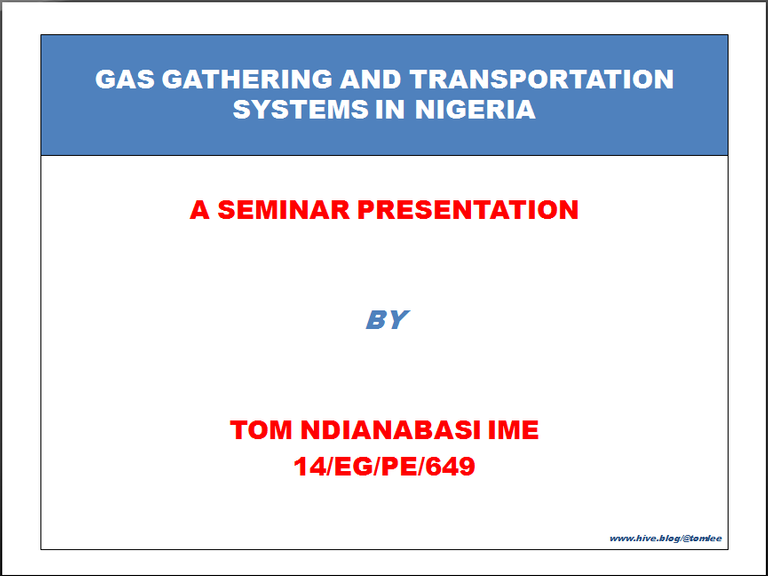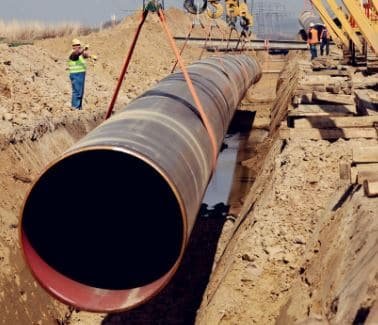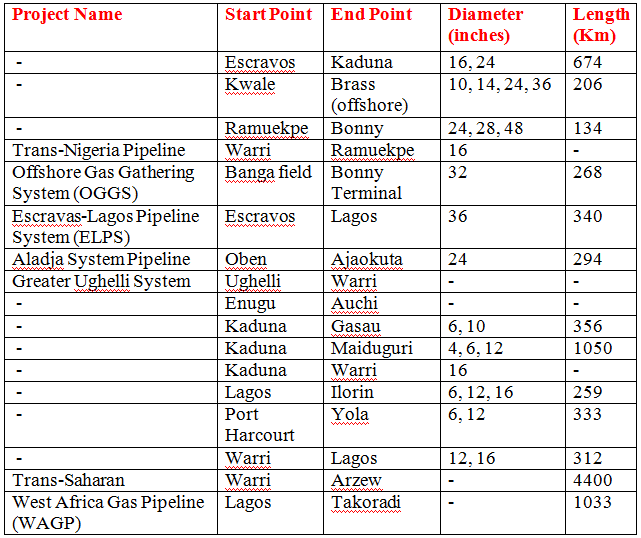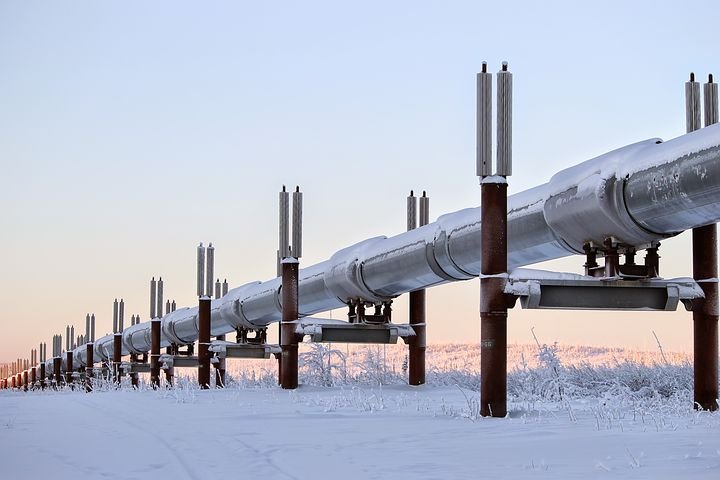Welcome to My Blog!

Today, I'd like to share with us a seminar I presented way back in 2019 when I was still in the University for my first degree programme. I hope you stay glued to the end as it promises to be educating, informative and interesting. The topic of the presentation was "Gas Gathering and Transportation Systems in Nigeria."
It might interest you to know that in my country Nigeria, natural gas is being produced in large quantities from oil and gas wells following that its usage in the country keeps increase. In spite of the large production rate of natural gas in the country, the absence of an effective gathering and transportation system can only result in the wastage of this valuable and useful energy source. Transportation of natural gas is thus a very important aspect of the oil and gas industry and as such, it must be done with much efficiency and effectiveness. In view of this, pipelines have been recognized as the most economic, effective and safest way of transporting natural gas in Nigeria. The paper then focuses on the concepts and techniques of natural gas gathering and transportation systems in Nigeria. It also discusses on pipeline transportation of natural gas as well as other transportation systems. The paper then concludes that pipeline transportation is the dominant mode of gathering and transporting natural gas in Nigeria.
Natural gas is one of the most used and cleanest of all energy sources so far in existence. It is also a very vital component of the world’s supply of energy. The principal compositions of Natural Gas (NG) are methane, ethane, propane, butane and pentane. Note that; the natural gas system is generally described in terms of its production, purification, transmission, storage, and distribution.
It is not just enough to produce natural gas from oil and/or gas wells. For it to be appreciated, it has to maximized through using it to generate power. This makes its transportation a very vital aspect and bearing in mind its high inflammable nature, necessary cautions must always be taken. However, the efficient and effective movement of natural gas from producing regions to consumption regions (such as industries, plants, homes) requires an extensive and elaborate transportation system.

Source
On the other hand, Nigeria’s gas sector holds significant potential as studies show that Nigeria is home to Africa’s largest gas reserves. To further buttress this fact, experts also estimate that the reserves locked in the Nigerian soil is enough to last for as long as 500 years (Igwe, 2012).
In many instances, natural gas produced from a particular oil and/or gas well will always have to travel a great distance to reach its point of use. The transportation system for natural gas consists of a complex network of pipelines, designed to quickly and efficiently transport natural gas from its origin, to areas of high natural gas demand. Transportation of natural gas is closely linked to its storage: should the natural gas being transported not be immediately required, it can be put into storage facilities for when it is needed.
Gas Gathering System
The process or technique of collecting natural gas from the wellhead and moving it to a processing plant or to a major transmission line is termed as a gas gathering system. Consequent upon that, natural gas gathering system refers to the flow-lines network and process facilities that transport and control the flow of gas from the producing wells to a main storage facility, processing plant or shipping point. Thus, natural gas gathering systems are a fundamental aspect of the midstream sector and a successful, reliable system greatly improves output and profitability.
More so, a natural gas gathering system includes pumps, headers, separators, emulsion treaters, tanks, regulators, compressors, dehydrators, valves and associated equipment etc. There are two types of gathering systems, radial and trunk line. The radial type brings all the flowlines to a central header, while the trunk-line type uses several remote headers to collect fluid. The latter is mainly used in large fields. The gathering system is also called the collecting system or gathering facility. A gas gathering system works on the principle of gas moving from a higher pressure to a lower pressure.
Transportation of Natural Gas in Nigeria
As natural gas is typically produced in remote regions away from areas of high gas demand, natural gas transport is a critical part of the natural gas industry. Natural Gas transportation system refers to the various methods of transportation used to move natural gas from the producing areas (source points) to the consumption regions (demand points). Now, this process requires an extensive and elaborate transportation system. Research shows that several variables play significant role in the natural gas transportation system and some of the factors affecting the type of gas transportation method used at a particular scenario includes the gas reserves, time frame to monetize the gas, the distances to the markets, investments and infrastructure available and gas processing.
There are a number of options for transporting natural gas energy from oil and/or gas fields to the market and where its demands are high. Natural gas can be transported through any of the following means and methods; pipelines, liquefied natural gas (LNG), compressed natural gas (CNG), gas to solids (GTS), i.e., hydrates, gas to power (electricity), and gas to liquids (GTL).
The business of producing and delivering natural gas to the consumer is a complex process involving many different companies, departments or units. From the exploration and production companies, the raw gas is delivered to the processing plants; the processed gas is then transported via a high-pressure transmission system to a variety of domestic and industrial consumers through local distribution systems. However, it is worthy of note that in Nigeria, natural gas is primarily transported by pipeline (on land) and ship (on water).
Although pipelines can be built under the sea, the process seems to be more economically and technically demanding. Owing to this, the majority of oil at sea is being transported by tanker ships. Similarly, it is often more economically feasible to transport natural gas in the form of Liquefied Natural Gas (LNG), but the break-even point between LNG and pipelines would depend on the volume of natural gas to be transported and the distance it will travel.
Also, there have been a lot of issues arising from the construction of new transmission lines, as existing gas pipelines do not have enough capacity to fill gas demands from various sectors. Virtual-pipeline is thus an alternative method of transporting natural gas to places where there are no pipeline networks available.
Virtual pipeline is based on a modular system of compression or liquefaction, transport and decompression and/or re-gasification of natural gas, which communities, industries, gas stations and others can use. In virtual-pipelines compressed/liquefied natural gas is transported by various modes - highway, railway, waterways and the sea.
Pipeline Transportation of Natural Gas
By definition, a petroleum pipeline is a complex structure for transporting petroleum and petroleum products from the place of extraction or production to points of use. Also, pipeline transport can be said to be the long-distance transportation of a liquid or gas through a system of pipes - a pipeline - typically to a market area for consumption or usage. In case you are wondering what pipelines look like, oil pipelines are made from steel or plastic tubes whereas natural gas pipelines are constructed of carbon steel source.
Pipeline transportation has become an important means of moving natural gas. As a result of this and coupled with the expansion of the market and large demand; millions of pipeline have been laid overtime. Natural gas is moved through pipelines as a result of a series of compressors creating pressure differentials – the gas flows from an area of high pressure to an area of relatively lower pressure. Compressors are powered by electric or natural gas fired engines that compress or squeeze incoming gas and push it out at a higher pressure.
As one would expect, compressor stations for large transmission lines are much bigger than the compressors used to move the gas through the small distribution lines to our homes. Some gathering systems do not need compressors because the pressure of the gas coming out of the wells is enough to move the gas through the gathering lines.
Categories of Pipelines
Essentially, there are three main categories of transportation pipelines based on purpose and they include; gathering pipelines, transmission pipelines, and distribution pipelines. These pipelines focus on the extraction of materials, their long-term transport, and final delivery. Pipelines are also divided for jurisdictional purposes into two namely: Interstate pipelines and intrastate pipelines. Interstate pipelines carry natural gas across state boundaries, in some cases across the country. Intrastate pipelines, on the other hand, transport natural gas within a particular state.
Pipelines System in Nigeria

Own Image Data Source
There are numerous pipelines systems in Nigeria. However, just a few is being detailed in this paper.
Escravos - Lagos Pipeline System (ELPS)
The Escravos–Lagos Pipeline System (ELPS) is a natural gas pipeline built and commissioned in 1989 and runs from Escravos, Nigeria to Itoki terminal, Lagos, Nigeria. It is owned and operated by the Nigerian Gas Company Limited (NGC). The pipeline has the length of about 439 km (273 miles); a maximum discharge of 800 MMcf/d and a diameter of 36 inches (914 mm). It supplies gas from Escravos region of Niger Delta area to Egbin power station near Lagos in Nigeria. Subsequent spur lines from the ELP supply Delta power plant at Ughelli, Warri Refining and Petro-chemical Company at Warri, the West African Portland Cement (WAPCO) Plants at Shagamu and Ewekoro, industries at Ikorodu, City Gate in lkeja Lagos. Since the NIPP power plants emerged ELPS is the major gas supply artery to the power plants in Nigeria source.
The sources of natural gas supply to the Escravos Gas Plant (EGP) are discussed below:
- The pipeline starts at Escravos Gas Plant (EGP) operated by Chevron which has 680 MMcf/d capacity. The EGP facilities deliver 215 MMcf/d to the domestic gas market by Escravos–Lagos Pipeline. Part of 170 MMcf/d is transferred from Escravos to West African Gas Pipeline.
- Odidi gas plant operated by Neconde with actual capacity 40 MMcf/d.
- Utorogu gas plant operated by NNPC which has capacity 360 MMcf/d (ongoing upgrading to 510 MMcf/d).
- Oben gas plant operated by Seplat with capacity 300 MMcf/d.
Trans - Saharan Gas Pipeline
The Trans-Saharan Gas Pipeline (also known as NIGAL pipeline and Trans-African gas pipeline) is a planned natural gas pipeline from Nigeria to Algeria. It is seen as an opportunity to diversify the European Union's gas supplies. The pipeline is built and operated jointly by the Nigeria National Petroleum Corporation (NNPC) and Sonatrach. The pipeline has a capacity up to 30 billion cubic meters of natural gas annually with a diameter of 48 to 56 inches (1,220 to 1,420 mm).
West African Gas Pipeline (WAGP)
The West African Gas Pipeline (WAGP) is a natural gas pipeline to supply gas from Nigeria's Escravos region of Niger Delta area to Benin, Togo and Ghana. It is the first regional natural gas transmission system in sub-Saharan Africa. It has the length of 678 km (421 miles); a maximum discharge of 5 billion cubic meter per year and a diameter of 20 inches (508 mm).
In conclusion, Nigeria has an enormous oil and gas reserves and as such, natural gas is being produced in large quantities by oil and gas industries within the country. Owing to the many benefits and advantages natural gas possesses over many other energy sources, the demand for natural gas both for industrial and domestic purposes keeps increasing. This in turn makes gas gathering and transportation a major aspect in the oil and gas industry. However, there are various ways of transporting natural gas but pipeline transportation happens to be the dominant mode of transporting natural gas from production facilities to final consumers in Nigeria. This is so because pipeline transportation of natural gas offers a more economical, safe and effective means of moving this energy source.
References
- Pipeline transportation of petroleum products in nigeria
- Escravos Lagos Pipeline System
- Natural gas pipelines in Nigeria
- https://theodora.com/pipelines/nigeria_oil_gas_and_products_pipelines_map.html
- Pipeline Transport - Wikipedia
@steemstem set as beneficiary of this post.

I assume that with such a transport system, one must deal with many live checks that the pipeline network is safe, unbroken, etc. Do you have information on this topic?
I can always find information pertaining to that.
But there have been cases of Pipeline vandalism by some bittered citizens.
So the surveillance system is not as good as it should, isn't it? Bloody humans, although I was more thinking about natural issues or aging, TBH... ;)
Thanks for your contribution to the STEMsocial community. Feel free to join us on discord to get to know the rest of us!
Please consider supporting our funding proposal, approving our witness (@stem.witness) or delegating to the @stemsocial account (for some ROI).
Thanks for including @stemsocial as a beneficiary, which gives you stronger support. Using the STEMsocial app could yield even more supporti next time.